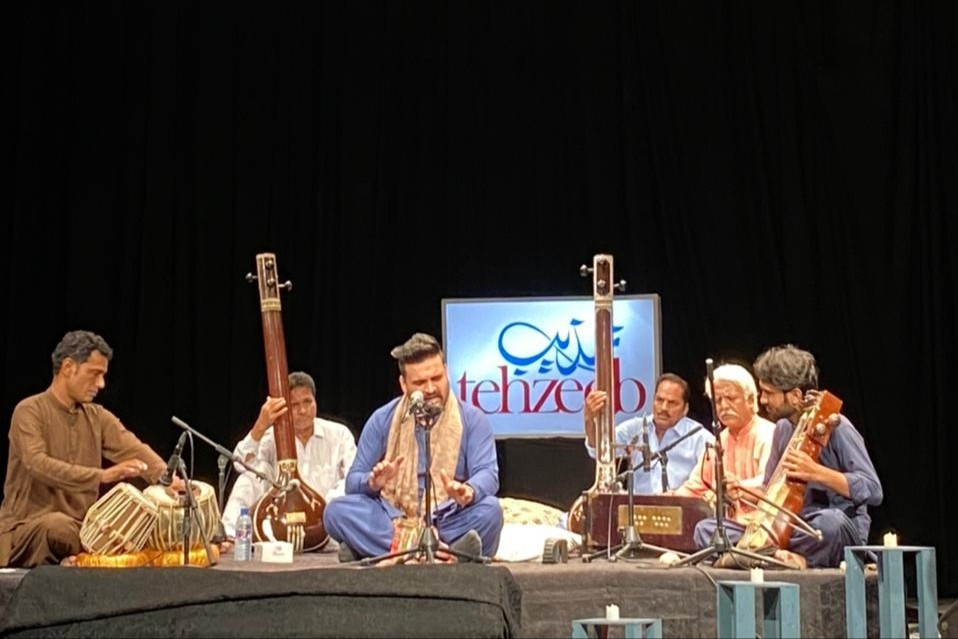
Music is a wholly temporal phenomenon. It is time embellished, existing in a realm completely separate from the visual. This separation can often lead to ecstatic experiences, aiding listeners briefly blinded to the source of their pleasure to contemplate the divine in the empty space. However, for the uninitiated, especially when it comes to music belonging to the South Asian classical tradition, visuality can be the key to a deeper understanding and appreciation of the art form. The way the tabla nawaz strikes their instrument, or the dexterity with which the sitar nawaz moves their fingers to create a stream of beautiful music helps bridge the gap caused by unfamiliarity with the genre for newer listeners. Through viewing the mathematical complexity of its production, the music is elevated and its nuances made somewhat accessible.
Such is the power of live music, even when pre-recorded and presented through the constricted dimensions of television or smartphone screen. The Tehzeeb Foundation’s recent recordings for their annual music festival, this year presenting its 12th edition, hope to revive the South Asian musical tradition in the mainstream through the newly-realised power of the digital space. While South Asian classical music still thrives in the basic makeup of popular South Asian music, be it through Bollywood or Coke Studio, purer forms of it have been relegated to the realm of the past, serving purposes of nostalgia alone (at least in the eyes and ears of younger, uninitiated listeners).
Classical music is difficult to enjoy for the untrained ear, and it is understood that this musical style demands investment. Entertainment is at the core of popular music (which in no way reflects negatively on the merits of it. After all, Alf Layla Wa Layla was pop literature) but the classical tradition thrives on the idea of enlightenment, and the latter is not achieved easily.
However, once acquainted, the experience of classical music is truly unmatched. 24-year-old sitar nawaz Ritika Dhanja, who was part of the setlist at the festival, reflected on the desire of the new student to play popular music on their instrument. “When I was younger, I would beg my ustaad to teach me songs that I knew. He remained steadfast in his approach, explaining to me that mastering classical music meant mastering popular music as well. It is much more difficult, but also so much more rewarding in the long run,” she explained.
An arresting and dexterous tabla jugalbandi by Ustad Bashir Khan and Yousuf Bashir during the festival was a sonic as well as a visual feast. The way the tabla nawaz’s hands moved over his instrument, at times shifting positions so fast they felt momentarily blurred, was a true embodiment of the mathematical prowess required to master the tabla, a staple of South Asian classical music.
The performance of a thumri by vocalist Shahzeb Ali felt elevated by the subtle changes in his facial expressions with each rise and fall of the singer’s voice. The festival also included performances by prominent folk musicians, with Akbar Khameeso treating the audience of connoisseurs to a soulful performance on the flute-like alghoza, evoking images of open fields and calming winds, and Zulfiqar Faqeer performing a tune on the borendo, one of the oldest wind instruments originating in Mohenjo-Daro. The latter concluded his performance with a rendition of the popular folk melody Tere Ishq Nachaiyya, the familiarity of which sent a ripple of excitement throughout the audience, manifesting as broad smiles spread across the small National Academy of Performing Arts (Napa) auditorium.
While the syncretic South Asian classical tradition is rooted firmly in the past (although the issue of postcolonial identity politics leaves this past somewhat muddled), the space for innovation and evolution within it is in many ways boundless. The incorporation of western instruments such as the harmonium and violin within the genre is a testament to its fluidity and acceptance. During the recordings, director of Tehzeeb Foundation Sharif Awan explained that while the raag remains fundamentally unchanged, the composition continues to evolve and shift. He likened the musical composition to a conversation, with varying arrangements of language and stressors. Awan, in an earlier conversation, took issue with popular fusion music over its lack of compositional innovation, which he believes could help take the tradition forward and evolve within the mainstream, not leaving it to stagnate, enshrined as an art form of the past.



1716998435-0/Ryan-Reynolds-Hugh-Jackman-(3)1716998435-0-165x106.webp)






-(1)1729587810-0/Copy-of-Untitled-(50)-(1)1729587810-0-270x192.webp)




1730706072-0/Copy-of-Untitled-(2)1730706072-0-270x192.webp)
COMMENTS
Comments are moderated and generally will be posted if they are on-topic and not abusive.
For more information, please see our Comments FAQ